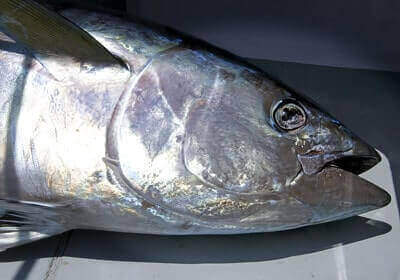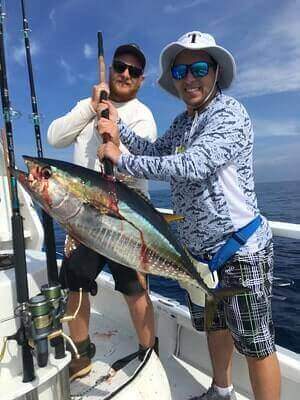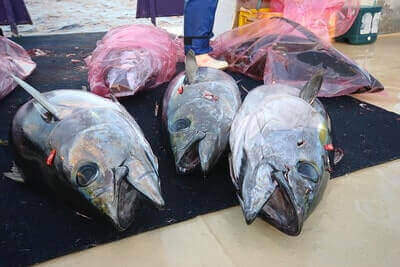Disclosure: We may earn commissions if you purchase products after clicking on a link from our site.
Have you always relished fishing monster bigeye tuna? Do you want to learn how to catch bigeye tuna? Bigeye tuna is one of the most sought-after gamefish. They move in “wolf packs”, can be nowhere in sight, and then in a split second, they explode with a lot of power. Bigeye tuna can seriously hurt you even if you do everything right as they are so large and powerful.
In this article, we discuss tips, tricks, and techniques on how to catch bigeye tuna. Additionally, we discuss the baits and lures that are effective when fishing for bigeye, and the fishing tackle to succeed with the monster of a fish.

Table of Contents
How To Catch Bigeye Tuna
1. Trolling
Trolling is a popular method for catching bigeye tuna, particularly when targeting them in offshore waters. Anglers use specialized trolling gear, including heavy-duty rods and reels, along with large trolling lures designed to mimic the baitfish that bigeye tuna feed on. These lures are typically trolled behind a boat at various speeds to cover a wide area of water.
Anglers may employ tactics such as staggered trolling lines or the use of outriggers to spread their lure presentation and increase their chances of attracting bigeye tuna. Trolling allows anglers to cover vast expanses of open water where bigeye tuna are known to roam, making it an effective method for locating and hooking these powerful fish.
2. Drift Fishing
Drift fishing is a popular method for targeting bigeye tuna, especially in offshore waters where these fish are known to congregate. Anglers employ this technique by allowing their boat to drift naturally with the prevailing currents while presenting baits or lures to entice bigeye tuna strikes.
Typically, anglers deploy a variety of baitfish, such as mackerel, bonito, or squid, rigged on heavy-duty hooks and leader rigs, at various depths in the water column. Additionally, large trolling lures or jigs may also be employed to target bigeye tuna during drift fishing expeditions.
Anglers must carefully monitor their drift speed and direction to ensure optimal presentation of baits or lures in areas where bigeye tuna are likely to be feeding. Drift fishing allows anglers to cover a wide area of water and effectively target bigeye tuna in their natural offshore habitats. For more information on bigeye tuna fishing techniques, visit NOAA Fisheries.
3. Night Fishing
Night fishing for bigeye tuna is more productive than fishing during the day.
The reason is simple: bigeye tuna come closer to the surface at night to prey on baitfish, squid, and other prey. This makes them more active at night and makes it a great time to fish for bigeye tuna.Night fishing for bigeye tuna is a strategic approach employed by anglers seeking to capitalize on the predatory behavior of these large fish during nocturnal hours. Anglers often target bigeye tuna at night due to their tendency to feed closer to the surface under the cover of darkness.
This method typically involves deploying a spread of baited lines or trolling lures behind the boat while navigating through offshore waters. The use of specialized lighting systems, such as underwater lights or deck lights, can attract baitfish and plankton, which, in turn, draw bigeye tuna to the vicinity of the boat.
Anglers may also employ electronic fish-finding equipment to locate schools of bigeye tuna beneath the surface during nighttime expeditions. Once located, anglers present live bait, such as squid or small fish, rigged on heavy-duty tackle to entice bigeye tuna strikes.
Night fishing requires careful planning, navigation, and the use of specialized equipment to maximize success in targeting bigeye tuna under low-light conditions. For more information on bigeye tuna fishing techniques, visit NOAA Fisheries.

4. Butterfly Jigging
When bigeye tuna are deep in the water column, butterfly jigging is one fishing method that anglers use to target bigeye. The jigs that are used are called butterfly jigs because of the flutter-like zigzag motion they produced under the water. The jig moves with this pattern because of the way the edges of the lures are cut.
This movement of the butterfly jig gets the attention of the bigeye tuna and entices them to strike. The Shimano Butterfly jig is one of the butterfly jigs that are very effective when fishing for bigeye tuna.
5. Chunking
Chunking is a technique commonly used by anglers to target bigeye tuna, especially when fishing in deeper offshore waters. It involves cutting up large chunks of baitfish, such as mackerel or bonito, and dispersing them in the water to create a scent trail to attract bigeye tuna. Anglers deploy chunks of baitfish attached to heavy-duty hooks and leader rigs at various depths in the water column, ranging from near the surface to deeper depths where bigeye tuna are known to congregate.
Once the scent trail attracts bigeye tuna to the area, anglers patiently wait for a strike, often employing live baitfish or squid as additional offerings to entice the fish to bite. Chunking requires precise bait deployment and a keen understanding of bigeye tuna behavior to maximize success.
6. Vertical Jigging
Vertical jigging is a highly effective method for targeting bigeye tuna, particularly when fishing over underwater structures or seamounts where these fish are known to gather. Anglers use heavy metal jigs designed to mimic the movement of injured or fleeing baitfish, which bigeye tuna find irresistible.
By dropping these jigs vertically through the water column and imparting erratic movements using rod twitches and jerks, anglers can trigger aggressive strikes from bigeye tuna. Vertical jigging allows anglers to precisely target specific depths where bigeye tuna are holding, making it a versatile and productive technique for catching these prized game fish.
7. Live Bait Fishing
Live bait fishing is a traditional and effective method for targeting bigeye tuna, particularly in areas where live baitfish such as mackerel, bonito, or squid are abundant. Anglers rig live baitfish on heavy-duty hooks and leader rigs, then deploy them either on the surface or at various depths in the water column using techniques such as kite fishing, balloon fishing, or downrigging.
Live bait fishing allows anglers to present natural-looking prey to bigeye tuna, increasing the likelihood of enticing strikes. Anglers must use sturdy tackle and employ proper bait-handling techniques to ensure that live baitfish remain lively and attractive to bigeye tuna.
8. Deep Dropping
Deep dropping is a specialized fishing method used to target bigeye tuna in deep offshore waters, typically at depths exceeding 1,000 feet. Anglers use electric or manual reels to deploy heavy sinkers and bait rigs equipped with large hooks and baitfish or squid as bait.
These rigs are lowered to the desired depth, where bigeye tuna are known to congregate, and then jigged or drifted along the seafloor or through the water column to attract strikes. Deep dropping requires specialized equipment and precise boat positioning to effectively target bigeye tuna in their deepwater habitats.
9. Chumming
Chumming is a technique used to attract bigeye tuna to the vicinity of the boat by dispersing a mixture of ground-up baitfish, fish oil, and other attractants into the water. Anglers deploy a chum slick or chum bag attached to the boat, which releases a steady stream of chum into the water, creating a scent trail that can attract bigeye tuna from a distance.
Once bigeye tuna are attracted to the chum slick, anglers can present baits or lures to entice strikes. Chumming can be an effective method for bringing bigeye tuna within casting or trolling range, increasing the chances of hooking into these powerful and prized game fish.
Bigeye Tuna Fishing Tackle
Bigeye tuna grows to be a very large and powerful fish; therefore, a heavy-action rod will work well when fishing for bigeye. A reel that matches the heavy-action rod will work well for bigeye fishing. Additionally, a 50- to 80-pound main line, a 200-pound top shot, a leader, and 11/0 hooks will work.
Best Baits For Bigeye Tuna
- Squid
Squid serves as a highly effective bait for targeting bigeye tuna due to its natural appearance, scent, and texture, making it irresistible to these voracious predators. Anglers often employ squid as bait when fishing for bigeye tuna by rigging whole or partial squid on heavy-duty hooks attached to sturdy leaders.
The rig is typically deployed at various depths using downriggers or weighted lines to present the bait at the desired depth range where bigeye tuna are known to congregate. Squid can also be used in conjunction with other baitfish or artificial lures to enhance its appeal and increase the chances of attracting bigeye tuna strikes.
When rigging squid as bait, anglers may opt to add additional scent attractants or reflective tape to mimic the natural bioluminescence of squid in the water, further enticing bigeye tuna to strike. This baiting technique requires precision in presentation and understanding of bigeye tuna behavior to achieve optimal results. For more information on using squid as bait for bigeye tuna fishing, visit NOAA Fisheries.
2. Small Mackerels
Small mackerel serves as an excellent bait for targeting bigeye tuna due to its oily flesh and natural swimming action, which mimics the movement of the tuna’s preferred prey. Anglers often catch small mackerel using live bait rigs or small trolling lures, such as feathers or spoons, to imitate the baitfish’s appearance and movement.
Once caught, anglers rig the small mackerel onto heavy-duty hooks, either whole or as cut bait, and deploy them using downriggers, planers, or weighted lines to present the bait at various depths where bigeye tuna are known to feed. The oily scent and natural swimming action of small mackerel makes them highly attractive to bigeye tuna, enticing strikes even in deep offshore waters.
Additionally, anglers may choose to brine or marinate the mackerel in fish oils or scent attractants to further enhance their effectiveness as bait. Successful bigeye tuna fishing with small mackerel requires patience, precise presentation, and a keen understanding of tuna behavior and feeding patterns. For more information on using small mackerel as bait for bigeye tuna fishing, visit NOAA Fisheries.
3. Sardines
Sardines are a popular bait choice for targeting bigeye tuna due to their oily flesh and strong scent, which can attract big game fish from a distance. To catch sardines for bigeye tuna fishing, anglers typically use sabiki rigs, which are multiple-hook rigs adorned with small, shiny lures that mimic the appearance of small baitfish like sardines.
Anglers deploy these rigs near baitfish schools or underwater structures where sardines congregate, such as reefs, wrecks, or buoys. Once the sardines are hooked, anglers keep them alive in bait tanks or coolers with aerators to maintain their freshness and vitality. To rig sardines for bigeye tuna fishing, anglers use circle hooks or J-hooks, depending on regulations and personal preference, and often employ a bridle rigging method to secure the bait securely while allowing for natural movement in the water.
The strong scent and lifelike swimming action of sardines make them irresistible to bigeye tuna, especially when presented at the appropriate depth and location. Anglers may also enhance the sardines’ appeal by soaking them in fish oils or scent attractants before deployment. For more information on using sardines as bait for bigeye tuna fishing, visit NOAA Fisheries.
4. Mullet
Mullets serve as effective bait for targeting bigeye tuna, renowned for their rich flavor and strong scent, which can entice these powerful predators. To acquire mullets for bigeye tuna fishing, anglers often utilize cast nets or seine nets to capture them in coastal waters where mullets are abundant. These baitfish are typically found inshore near estuaries, flats, or mangrove-lined shorelines, making them accessible to anglers from both shore and boat.
Once caught, mullets are kept alive in bait tanks or coolers with aerators to preserve their freshness and vitality. To rig mullets for bigeye tuna fishing, anglers may use various techniques, including nose-hooking or tail-hooking, depending on the desired swimming action and presentation. Circle hooks or J-hooks are commonly employed to secure the mullets to the fishing line, ensuring a solid hookset when a bigeye tuna strikes.
Mullets can be fished either on the surface, suspended mid-water, or near the bottom, depending on the preferred feeding depth of the target species and the fishing conditions. Their natural appearance and movement in the water make mullets an enticing option for bigeye tuna, particularly when presented in areas with known tuna activity. For more information on using mullets as bait for bigeye tuna fishing, visit NOAA Fisheries.

Best Lures For Bigeye Tuna
- Jigs
Jigs are versatile lures widely used by anglers targeting bigeye tuna, offering an effective method to entice these powerful fish. Available in various shapes, sizes, and colors, jigs mimic the movement of prey species, making them irresistible to bigeye tuna.
Anglers often deploy jigs by vertically jigging them up and down through the water column or casting them out and retrieving them at different speeds to imitate fleeing baitfish. The reflective surfaces and lifelike movements of jigs make them particularly appealing to bigeye tuna, which are known for their aggressive feeding behavior.
To enhance the effectiveness of jigging for bigeye tuna, anglers may use heavy-duty tackle to handle the strong and fast runs characteristic of these fish. Additionally, fishing during low light conditions or at night when bigeye tuna are more active can increase the chances of success.
For more information on bigeye tuna fishing regulations and best practices, anglers can refer to resources provided by the National Oceanic and Atmospheric Administration (NOAA) Fisheries.
2. Trolling Lures
Trolling lures are highly effective tools for targeting bigeye tuna, offering anglers a versatile and productive method to entice these prized fish. These lures come in various shapes, sizes, and colors, designed to mimic the movement and appearance of natural prey species. When trolling for bigeye tuna, anglers typically deploy multiple lines equipped with trolling lures behind a moving boat, covering a large area of water to increase the chances of encountering feeding fish.
The key to successful trolling for bigeye tuna lies in varying the trolling speed, depth, and lure presentation to match the preferences of the fish and the prevailing conditions. Anglers may use downriggers or planers to achieve different trolling depths and target bigeye tuna at various water levels.
Additionally, incorporating natural bait or scent attractants with trolling lures can enhance their effectiveness, enticing bigeye tuna to strike. To optimize trolling success for bigeye tuna, anglers should monitor water temperature, currents, and other environmental factors to locate productive fishing grounds. For more information on bigeye tuna fishing regulations and best practices, anglers can refer to resources provided by the National Oceanic and Atmospheric Administration (NOAA) Fisheries.
Bigeye Tuna Fishing Tips
- The best time to catch bigeye tuna is at dawn or dusk.
2. When it is a full moon, bigeyes will eat all night. When learning how to catch bigeye tuna, this is good to know.
3. While looking for bigeye tuna, if you spot pilot whales in the water, that is a good sign that bigeye tuna is around. The baitfish for bigeye tuna is usually underneath the whales and the bigeye is also there.
4. Warm waters, above 70 degrees, are important for bigeye tuna bites.

5. You can catch bigeyes all day long when it is foggy.
6. Canyons, cliffs, and points are good areas to look for bigeyes.
7. The best time of the year to catch bigeyes is late spring through early fall.
8. Bigeye tuna spend most of their day at depths greater than 250 feet, often going as deep as 1,500 to 1,600 feet looking for food.
9. Bigeye tuna often hunt structures where baitfish can be found, including seamounts, canyon walls, and high flyers.
10. Fish for bigeye tuna in low light conditions. Most are caught just before dark or at first light.

11. Always log your catches of bigeye as time and time again, you will find bigeye tuna in the exact spots you hit some of them a year or two earlier.
12. Be on the lookout for porpoises, birds, and fish oil slicks. There is a high chance that you will hit bigeye tuna not far from feeding porpoises and other birds.
13. A general rule of thumb for spreads is that the spread should be tighter to the boat than the standard daytime-trolling pattern.
14. Speed should be 6 to 8 knots so the lures are swimming in a way that entices the bigeye tuna.
15. Short and stocky lures in the 8- to 10-inch range are good for fishing bigeye tuna.

16. Dark color lures are more pronounced in dim conditions.
17. The Braid Bigeye Rocket, with the skirt trimmed, and placed at the back or off a corner rod can be very productive when fishing for bigeye tuna.
18. Bigeye tuna spawn throughout the year, summer is the month that they spawn the most.
19. Bigeye tuna can spawn two or more times a year.
The Bottom Line
Bigeye tuna is a favorite gamefish for anglers who really like the dangerous game of battling with monstrous and very powerful fish. They are explosive and powerful and if you are not well prepared, can get seriously injured. Bigeye tuna can be found in the Indian, Atlantic, and Pacific Oceans.
In this article we discussed how to catch bigeye tuna, the fishing methods anglers use to catch bigeye, the fishing tackle, baits, and lures, as well as fishing tips to successfully accomplish your dream of catching this monster of a fish. You can also read how to catch yellowfin tuna, how to catch blackfin tuna, how to catch Albacore tuna, and how to catch bonito.